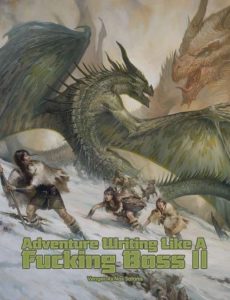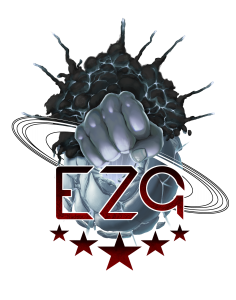Adventure Writing Like A Fucking Boss II (system neutral)
Adventure Writing Like A Fucking Boss II (system neutral)

The second of Venger’s advice-pdfs on the art of adventure-writing clocks in at 18 pages,1 page front cover,1 page kort’thalis glyph, 1 page editorial, leaving us with 15 pages of content, though it should be noted that there are no less than 4 truly stunning full-page b/w-artworks inside. (Plus a half-page one.)
The original Adventure Writing Like a Fucking Boss pdf, ultimately, at least for me, turned out to be a bit of a disappointment, as it focused on adventure writing for a group, and did not even briefly talk about the aspects of, you know, commercial adventure writing and the ins and outs there, so let’s see if this fares better!
We are off to a promising start, where Venger outlines his personal 3-month writing process, and then proceeds to note an overview of the module – her, I’d like to note that most customers, me included, actually do prefer getting a synopsis to contextualize the adventure, so yeah, his notion of providing an overview may be noted as not exactly required, and he is right in that insertion, but it’s definitely something that’s preferred by most folks out there.
We next move towards the importance of artwork and the importance of a map and when to include them. Personally, I’d like to add that a key-less, unlabeled map, sans secret doors etc., particularly in the age of VTTs, is a big draw. Include one, if at all possible! Venger’s discussion of artwork, particularly cover art (and interior art) also is wise. Folks will want nice artwork, and his suggestions for art-distrubtion make sense. I also like how he explicitly notes that there are multiple styles, and that full-color artwork doesn’t always trump b/w-artwork – a fact that this book perfectly illustrates with its lavish artworks. In a hilarious “teaching by showing moment”, he has a sentence in an atrocious font in the middle of the page, stating that the module should, you know, use a proper font that’s easy to read. As someone who has actually gotten migraines from having to stare for hours on end on a sucky font that is hard on the eyes, I found myself thinking: “Yes! This x1000!”
His discussion on finding a balance between being overtly descriptive and being bland, the daring to leave gaps for further adventuring, also rang true. I also liked that he clearly states that you don’t want just an outline – other folks will run it, so you need to abstract what you know and provide a more detailed adventure than some GM-notes. I genuinely did not expect to see this piece of advice, as Venger is very fond of evocative adventure outlines, but yeah – big kudos for abstracting author-bias here!
The next page then deals with the ingredients of your adventure – you should offer an evocative location, and the pdf does note that the PCs should have means to chew the scenery, interact and gain benefits…but balance that with not handing things out too easily. The insertion of complications also helps here. I’d also like to affirm that we don’t need a full curriculum vitae for every NPC. Unless it’s relevant for the plot, the GM doesn’t need to have spelled out that a certain NPC is lactose intolerant, when specific NPCs have their bowel-movements, etc. Crucial details to set them apart help, but don’t go overboard.
This piece of advice also ties in with a truly helpful observation: Monsters should have something to do. An ogre in a barrel-filled room? Boring. An ogre in a drunken rage, barricaded behind barrels, throwing them at PCs? Now that is interesting! Adverbs and adverbials are your friends, even in brief encounter-lines. This aspect, mechanically, also ties in with GM agency, something that you should definitely account for. The pdf also provides notes on (optional, obviously!) twist endings, so you don’t end up Shyamalan-ing your module. We all know at this point that Venger’s fond of random encounter tables, and so am I – his advice here is something that I’d second – though I’d note another aspect that the pdf doesn’t mention. Random encounters can be used to ground a module in a semblance of realism and plausibility. Many classic-style adventures do that, focusing on a few bandits and humanoids, perhaps some animals and vermin – this can end up being boring if the module doesn’t offer much more exciting this, but if you need to contrast the regular landscape from the dimension-tearing hellscape that this meteorite impact created, well, then a deliberately mundane random encounter table, contrasted by a full-blown bonkers and weird one, can really help distinguish components.
The pdf also provides a few notes on encounter design – if the encounter’s barely worthy of a footnote, describe over it. Don’t let mighty heroes (and their players) waste their time with crappy low-level foes…unless they are still a threat and part of a war of attrition before the big bad guy, but then again, they’ll be mid-level foes then…but that is my addition to the advice provided. Conversely, advice for which encounters to maximize and tweak is also noted. (Nice aside: A little box features a great twist that will make many a GM better for having read it…no, not going to spoil it here…)
4 general, different types of ending scenario are presented as well, and some bullet points to determine what should and shouldn’t be included in NPC-introduction are rather helpful. The formatting of stuff that is obvious, and stuff that is hidden, as noted in the advice provided for room description, is nice. If the module has a map, you won’t need dimensions – if it doesn’t, be sure to note them! Otherwise, the GMs and players will be stumbling through an abstract blob of a dungeon, and not in a good way. The pdf also notes that not all trailer-like first ideas can, in the end,c arry a whole adventure – and that linear dungeons are boring as all hell.
Venger came up with a good phrase here: “Needs more tentacles” – this doesn’t refer to tentacles per se, but is a call to be exceptional, to add this one twist to make it dark, make it weird, make it memorable. Similarly, his notion of creating images that stick “like Golden Honey” is something that can I can subscribe to; while a flawed freshman offering, Venger’s very first module, “Liberation of the Demon Slayer” may have a couple of weakpoints…but it’s not boring. In fact, many of his adventures have at least this one resounding, great imagery that just…sticks. The means by which a greater whole and moods can be conveyed is also highlighted here.
The pdf also, another pleasant surprise, actually deals with rules required for an adventure – that you should not rewrite game-rules, but that you well should provide new ones if required. The potential importance of factions and how to make them compelling is similarly discussed.
And then, the supplement provides advice that really helped ole’ me. How to be funny. I am not funny. I suck at writing funny or cute. I do horrific, dark and disturbing rather well, but that’s about it – the advice provided here is definitely appreciated. Aesthetic concerns, like how to present vital information, makes sense and quite a few folks should take a look here. He also notes that getting excited about writing something’s a good sign…and vice versa. We also, once more, have a serious and helpful checklist that should help authors avoiding railroading players.
And finally, the pdf talks about reviewers and roughly categorizes them in three categories, which somewhat mirrors my experiences. I certainly hope that I’d be classified as a neutral reviewer, i.e. someone who talks about the good and bad of a product. I’d also like to state that his advice on finding a reviewer that understands your design is appreciated – and his warning that one has to acknowledge that nothing’s perfect would make my job infinitely easier. If I had a dime for every time someone take criticism of a supplement as a direct attack and responded with vitriol…
Conclusion:
Editing and formatting are top-notch, I noticed no typos or the like. Layout is gorgeous, as we’ve come to expect from Kort’thalis Publishing – veins and splotches lighten the pages without diverting attention from the text. The b/w-artworks, with a Conan/Red Sonja piece, warriors and a slightly suggestive (but perfectly PG 13) one, as well as that of a female being dragged, unconscious, into the maw of a monster, while a hero jumps down, axe ready, are pretty damn kickass; certainly beyond what you’d expect from such an inexpensive file. The pdf comes fully bookmarked for your convenience and also features a second, more printer-friendly version.
Venger’s second advice-booklet on the art of adventure-writing turned out to be an impressive surprise for me. This little booklet compiles a ton of genuinely helpful and clearly put pieces of advice that really help you start making great adventures. While it is, by necessity of scope and by being system neutral, not an all-encompassing advice pdf that can get into the details of the respective systems, but it’d be unfair to expect this.
What we do have here, is a little gem of a checklist, quite frankly the opposite in utility when compared to the first pdf. Much to my pleasant surprise, Venger has succeeded in extrapolating much of his own aesthetic bias, which only shines through where it belongs – in examples, in the way in which he illustrates his points. We’re left with a surprising amount of wisdom and plain good guidance for new adventure-writers, particularly considering the brevity of this pdf. This is much more useful than many comparable books, stripped of superfluous meanderings, and, and that is important to note for Venger’s writing, it is genuinely well-structured. It doesn’t jump back and forth and provides a vivid and helpful guideline for writing modules that is, as a final plus, also surprisingly fun to read. All in all, this can be considered to be a resounding success, well worthy of 5 stars + seal of approval…and if this represents his accumulated knowledge, consider me very excited about his current project Cha’alt!
You can get this genuinely helpful advice-pdf here on OBS!
Speaking of Cha’alt – Venger offers a limited edition hardcover in the KS, and he’s actually got quite a massive old-school sandboxy science-fantasy setting going, one that warrants taking a look! You can check out the KS here!

Endzeitgeist out.

Thanks for the review, hoss!
I actually do take your advice on occasion, which is probably why volume 2 is so different from volume 1. They’re like two sides of the same coin, and you can get both combined in a single softcover on Amazon.
I’m excited about bringing Cha’alt to life, so thanks for mentioning the kickstarter, too!
Incidentally, I’d love to read some of your vitriolic feedback, made anonymous, of course, by blacking out the names, emails, etc. I’m sure your many Patreon supporters would agree. 😉
VS